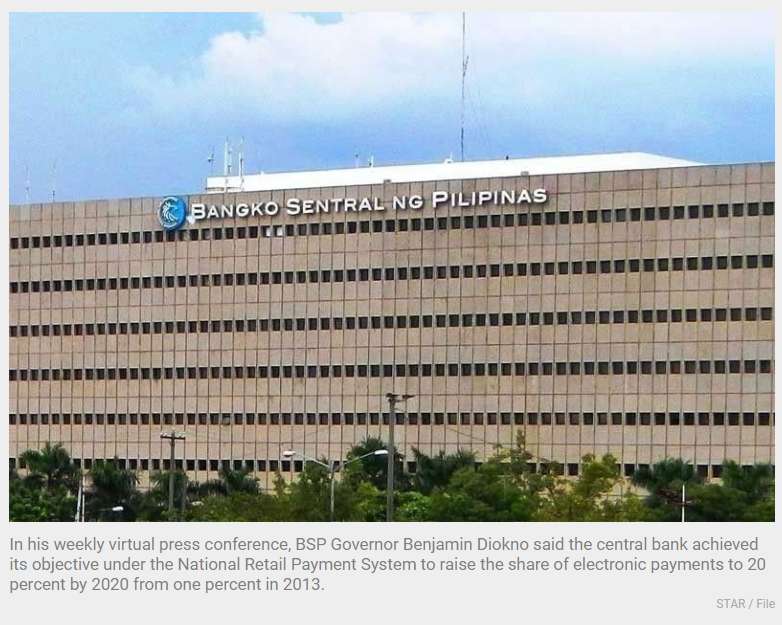Philippines: E-payment transactions breach BSP’s 20% target
MANILA, Philippines — The share of digital payments to total retail transactions topped 20 percent last year as the pandemic served as a catalyst to digitalization, the Bangko Sentral ng Pilipinas said.
In his weekly virtual press conference, BSP Governor Benjamin Diokno said the central bank achieved its objective under the National Retail Payment System (NRPS) to raise the share of electronic payments to 20 percent by 2020 from one percent in 2013.
“While the COVID-19 pandemic may have disrupted our way of life, it also created exceptional opportunities to boost digital payments and financial inclusion in the country,” Diokno said.
Based on latest BSP figures, the share of digital payments to the volume of retail transactions increased further to 20.1 percent in 2020 from 14 percent in 2019.
This means that one out of five payment transactions last year were done digitally.
On the other hand, Diokno said the share of electronic payments to the total value of transactions went up to 26.8 percent last year from 24 percent in 2019.
“We are seeing an accelerated rate of increase in the usage of digital payments. This could strongly indicate that Filipino consumers are moving away from conventional cash payments toward digital payments,” Diokno said.
The increase was traced to the 47.8 percent jump in payments to merchants, 18.1 percent rise in person-to-person (P2P) payments, and the higher payments made by government institutions for salaries and payrolls.
Under its Digital Payments Transformation Roadmap, the BSP committed to convert 50 percent of total retail transactions in the country to digital channels and increase the number of Filipino adults with bank accounts to 70 percent by 2023.
BSP Deputy Governor Mamerto Tangonan said the person-to-merchant (P2M) QR Ph to be launched soon would play a crucial role in achieving the targets set under the roadmap.
“The QR Ph P2M, which will be coming soon, would be of great impact because as we known merchant payments alone constitute 73 percent of total retail payments volume,” Tangonan said.
Tangonan pointed out the merchant payments is a rich field for harvesting additional digital payments growth.
“With these developments, we are confident that this will have a great impact on the further growth of digital payments,” Tangonan said.
Philippine Payments Management Inc. president Abraham Co said more initiatives such as the QR Ph P2M as well as invoicing among firms would be launched to complement the electronic fund transfers via PESONet and InstaPay.
Co added other initiatives include the PESONet multiple batch settlement, direct debit, request to pay, among others.
PPMI general manager Carmelita Araneta said challenges encountered by banks in digitalization include the enabling infrastructure in the country, the investments needed to upgrade core banking systems as well as fraud and cybersecurity issues arising from the use of digital platforms.
The health protocols that entailed social mobility restrictions in response to the COVID-19 pandemic have emerged to be a strong catalyst for the wider adoption of digital payments in the country.
More consumers are becoming digitally-engaged and have adapted to the use of digital payments for their financial transactions as shown by the sustained rise in the volume and value of merchant payments and remittances.
“The BSP will continue to perform its catalytic role to further advance the country’s digital payments transformation to promote the economic empowerment of our fellow Filipinos and ensure that everyone reaps the benefits from having universal access to digital payment services, especially during these extraordinary times,” Diokno said.
Source: https://www.philstar.com/business/2021/10/08/2132510/e-payment-transactions-breach-bsps-20-target


 Thailand
Thailand




